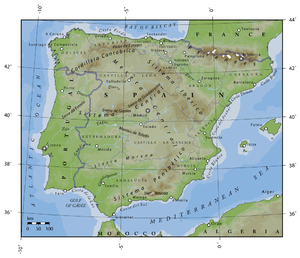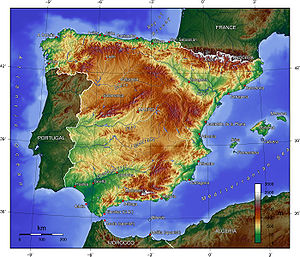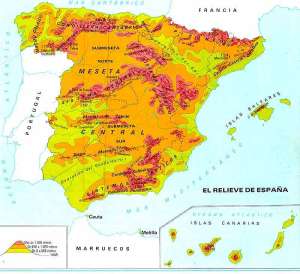http://online.seterra.net/es/ex/23
THE SOLAR SYSTEM
PLAY WITH THE NASA
8 Planets The Solar System Game. Create your own solar ... - Prongo
LABEL THE PLANETS
Astronomy Make A Solar System For Kids
Test para repasar:
El relieve de España
El relieve en Castilla y León.

THEME 5: ELECTRICITY AND MAGNETISM
To know more about electricity
Encyclopedia > Electric charge
Article Content
Electric charge
Electric charge is a fundamental conserved property of matter. Matter that possesses a charge is influenced by, and produces, electromagnetic fields. The interaction between charge and an electromagnetic field is the source of one of the four fundamental forces.Electric charge can be directly measured with an electrometer. Its unit is thecoulomb. Observed particles have charges which are integer multiples of theelectron charge which is a fundamental physical constant. Quarks are believed to have charges which are multiples of one-third the electric charge. The discrete nature of electric charge was demonstrated by Robert Millikan in his oil-drop experiment.
History
Charge was discovered by the Ancient Greeks who found that rubbing fur on various substances, such as amber, would build up an electric charge imbalance. The Greeks noted that the charged amber buttons could attract light objects such as hair. The Greeks also noted that if they rubbed the amber for long enough, they could even get a spark to jump. The wordelectricity derives from ηλεκτρον, the Greek word for amber.
By the 18th century, the study of electricity had become popular. One of the foremost experts was a man named Benjamin Franklin. Franklin imagined electricity as being a type of invisible fluid present in all matter. He posited that rubbing insulating surfaces together caused this fluid to change location, and that a flow of this fluid constitutes an electric current. He also posited that when matter contained too little of the fluid it was "negatively" charged, and when it had an excess it was "positively" charged. Arbitrarily (or for a reason that was not recorded) he identified the term "positive" with the type of charge acquired by a glass rod rubbed with silk, and "negative" with that acquired by an amber rod rubbed with fur.
We now know that Franklin's model was too simple. Matter is actually composed of two kinds of electricity: particles called protons which carry a charge of positive electricity, and particles called electrons which carry a charge of negative electricity. Rather than one possible electric current there are many: a flow of negative particles, or a flow of positive particles, or a flow of both negative and positive particles in opposite directions. To reduce this complexity, electrical workers still use Franklin's convention and they imagine that electric current (known as conventional current) is a flow of exclusively positive particles. The conventional current simplifes electrical concepts and calculations, but it ignores the fact that within some conductors (electrolytes, semiconductors, and plasma,) two or more species of electric charges flow in opposite directions. The flow direction for Conventional Current is also backwards compared to the actual electron drift taking place during electric currents in metals.
Properties
Aside from the properties described in articles about electromagnetism, it is worth noting that charge is a relativistic invariant. What this means is that any particle that has charge q, no matter how fast it goes, always has charge q. This property has been experimentally verified by showing that the charge of a helium nucleus (two protons and two neutrons bound together in a nucleus and moving around at incredible speeds) is the same as two deuterium nuclei (one proton and one neutron bound together, but moving much more slowly than they would if they were in a helium nucleus).
History
Charge was discovered by the Ancient Greeks who found that rubbing fur on various substances, such as amber, would build up an electric charge imbalance. The Greeks noted that the charged amber buttons could attract light objects such as hair. The Greeks also noted that if they rubbed the amber for long enough, they could even get a spark to jump. The wordelectricity derives from ηλεκτρον, the Greek word for amber.
By the 18th century, the study of electricity had become popular. One of the foremost experts was a man named Benjamin Franklin. Franklin imagined electricity as being a type of invisible fluid present in all matter. He posited that rubbing insulating surfaces together caused this fluid to change location, and that a flow of this fluid constitutes an electric current. He also posited that when matter contained too little of the fluid it was "negatively" charged, and when it had an excess it was "positively" charged. Arbitrarily (or for a reason that was not recorded) he identified the term "positive" with the type of charge acquired by a glass rod rubbed with silk, and "negative" with that acquired by an amber rod rubbed with fur.
We now know that Franklin's model was too simple. Matter is actually composed of two kinds of electricity: particles called protons which carry a charge of positive electricity, and particles called electrons which carry a charge of negative electricity. Rather than one possible electric current there are many: a flow of negative particles, or a flow of positive particles, or a flow of both negative and positive particles in opposite directions. To reduce this complexity, electrical workers still use Franklin's convention and they imagine that electric current (known as conventional current) is a flow of exclusively positive particles. The conventional current simplifes electrical concepts and calculations, but it ignores the fact that within some conductors (electrolytes, semiconductors, and plasma,) two or more species of electric charges flow in opposite directions. The flow direction for Conventional Current is also backwards compared to the actual electron drift taking place during electric currents in metals.
Properties
Aside from the properties described in articles about electromagnetism, it is worth noting that charge is a relativistic invariant. What this means is that any particle that has charge q, no matter how fast it goes, always has charge q. This property has been experimentally verified by showing that the charge of a helium nucleus (two protons and two neutrons bound together in a nucleus and moving around at incredible speeds) is the same as two deuterium nuclei (one proton and one neutron bound together, but moving much more slowly than they would if they were in a helium nucleus).
All Wikipedia text is available under the terms of the GNU Free Documentation License
Search Encyclopedia
|
Featured Article
|
How to build a charge detector.
CONOCIMIENTO DEL MEDIO. 6º PRIMARIA. TEMA 7: LA ENERGÍA.

JUEGA Y REPASA.
- Realiza las actividades interactivas y completa la autoevaluación del Tema 6. Recuerda que tienes que poner el código de tu libro. PULSA AQUÍ.
- Otras activividades y juegos de rapaso:
- La Energía y la electricidad. PULSA AQUÍ.
- LA ENERGÍA II. PULSA AQUÍ.
- ENERGÍAS RENOVABLES. PULSA AQUÍ.
- JCLIC: LA ENERGÍA. PULSA AQUÍ.
- JCLIC: EL CALOR Y LA TEMPERATURA. PULSA AQUÍ.
- JCLIC: EL CALOR Y LA TEMPERATURA II. PULSA AQUÍ.
- JCLIC: LOS USOS DE LA ENERGÍA. PULSA AQUÍ.
- JCLIC: REPASO DEL TEMA. PULSA AQUÍ.
3. OTRAS ACTIVIDADES DE AMPLIACIÓN.
- REPASA Y REALIZA EL EXAMEN EN PLANETA SABER:
- LA ENERGÍA. PULSA AQUÍ
- LABORATORIO VIRTUAL. PULSA AQUÍ.
4. OTRAS ACTIVIDADES DE AMPLIACIÓN. COMPLETA EN EL CUADERNO.
- ¿En qué lugares del mundo la población no tiene acceso a la energía eléctrica?
- ¿Qué es la contaminación lumínica? INFORMACIÓN AQUÍ.
- ¿Piensas que en el lugar donde vives se hace un uso moderado de la energía eléctrica? Razona la respusta.
COMBUSTIBLES Y CALENTAMIENTO GLOBAL.
QUÉ ES LA ENERGÍA
http://proyectos.cnice.mec.es/arquimedes/alumnosp.php?ciclo_id=1&familia_id=5&modulo_id=22&unidad_id=14
http://www.juntadeandalucia.es/averroes/html/adjuntos/2009/06/30/0002/0_ID/index.html
http://www.wikisaber.es/Contenidos/LObjects/what_is_energy/index.html
DE DÓNDE VIENE LA ENERGÍA?
http://contenidos.santillanaenred.com/jukebox/servlet/GetPlayer?p3v=true&xref=200606201402_PRE_0_1203175430&mode=1&rtc=1001&locale=es_ES&cache=false
FUENTES DE ENERGÍA O NECESITAN ENERGÍA?
http://contenidos.santillanaenred.com/jukebox/servlet/GetPlayer?p3v=true&xref=200606201409_AC_0_1235641919&mode=1&rtc=1001&locale=es_ES&cache=false
LA RUTA DE LA ENERGÍA
http://www.larutadelaenergia.org/index.asp
FUENTES DE ENERGÍA NO RENOVABLES
http://www.wikisaber.es/Contenidos/LObjects/non-renewable_sources_of_energy/index.html
FUENTES DE ENERGÍA RENOVABLES
http://www.wikisaber.es/Contenidos/LObjects/renewable_sources_of_energy/index.html
LA ENERGÍA SOLAR
http://blog.educastur.es/clarin3/2010/01/17/energia-solar/
http://proyectos.cnice.mec.es/arquimedes/alumnosp.php?ciclo_id=1&familia_id=5&modulo_id=22&unidad_id=14
http://www.juntadeandalucia.es/averroes/html/adjuntos/2009/06/30/0002/0_ID/index.html
http://www.wikisaber.es/Contenidos/LObjects/what_is_energy/index.html
DE DÓNDE VIENE LA ENERGÍA?
http://contenidos.santillanaenred.com/jukebox/servlet/GetPlayer?p3v=true&xref=200606201402_PRE_0_1203175430&mode=1&rtc=1001&locale=es_ES&cache=false
FUENTES DE ENERGÍA O NECESITAN ENERGÍA?
http://contenidos.santillanaenred.com/jukebox/servlet/GetPlayer?p3v=true&xref=200606201409_AC_0_1235641919&mode=1&rtc=1001&locale=es_ES&cache=false
LA RUTA DE LA ENERGÍA
http://www.larutadelaenergia.org/index.asp
FUENTES DE ENERGÍA NO RENOVABLES
http://www.wikisaber.es/Contenidos/LObjects/non-renewable_sources_of_energy/index.html
FUENTES DE ENERGÍA RENOVABLES
http://www.wikisaber.es/Contenidos/LObjects/renewable_sources_of_energy/index.html
LA ENERGÍA SOLAR
http://blog.educastur.es/clarin3/2010/01/17/energia-solar/
THEME 4: ENERGY
LIGHT:
Conocimiento del medio - 6º Primaria
Descubrir el funcionamiento del cuerpo humano a través de simulaciones y juegos, construir un circuito eléctrico virtualmente, o calcular el ángulo de reflexión de la luz con un gráfico interactivo... el contenido de Educaline es idóneo para descubrir y conocer las Ciencias de un modo visual e interactivo, ya que permite visualizar los procesos y recrearlos virtualmente.
A través de una base visual e interactiva, hace posible la asimilación de conceptos con ejercicios interactivos y otros recursos multimedia para aprender haciendo, facilitando la comprensión y favoreciendo la memorización al trabajar las relaciones entre ellos. Con actividades transversales complementarias y abundantes recursos de ampliación.
Ejemplo interactivo
ACTIVITIES: Miniproject
For this lesson we are going to find new alternative energy, in order we can improve the world.
In groups you will build machines or system in order to get energy.
It will be ecological and renewable energy. You have to present it at the end of the lesson.
First session1.- Download this worksheet. Watch this video
| |||||||||||||||||||||||||||||||||||||||||||||||||||||||||||||||||||||||||||||
| 1st day |
| |||||||||

|
|


Implantation (human embryo)
In humans (as in all other mammals, except for monotremes), implantation is the very early stage of pregnancy at which the embryo adheres to the wall of the uterus.[1] At this stage ofprenatal development, the embryo is a blastocyst. It is by this adhesion that the fetus receives oxygen and nutrients from the mother to be able to grow.
In humans, implantation of a fertilized ovum is most likely to occur about 9 days after ovulation, ranging between 6 to 12 days.

6º Primaria
Conocimiento del medio

1 - La nutrición
El ser humano obtiene la energía necesaria para sus funciones vitales a través de los alimentos. En el proceso intervienen numerosos sistemas y órganos (47 preguntas)
2 - La relación
A través del sistema nervioso, el ser humano capta los estímulos del exterior, a los que responde gracias a su aparato locomotor(35 preguntas)
3 - La reproducción
Mediante la reproducción, el ser humano es capaz de perpetuar la especie. Para ello, se necesitan dos individuos de sexo opuesto que unen sus gametos para crear un nuevo ser (26 preguntas)
4 - La energía
Gracias a las fuentes de energía podemos tener un modo de vida desarrollado. Para que éste sea sostenible, es necesario aumentar el uso de energía renovables y reducir la contaminación(22 preguntas)
5 - La luz y el sonido
La luz y el sonido son dos tipos de ondas que nos permiten ver los objetos que nos rodean y oír los sonidos de la naturaleza o producidos por el hombre(18 preguntas)
6 - La electricidad y el magnetismo
Todos los cuerpos tienen cargas eléctricas. Además, algunos de ellos tienen propiedades magnéticas capaz de atraer a objetos metálicos. Entre la electricidad y el magnetismo existe una gran relación. (19 preguntas)
7 - Las máquinas
Las máquinas nos permiten obtener fuerzas mayores realizando una fuerza mucho más pequeña. (11 preguntas)
8 - Geografía física de España
La geografía española se caracteriza por su gran diversidad según las zonas, lo que deriva en distintos climas, vegetaciones, vertientes hidrográficas...(33 preguntas)
9 - Geografía humana y política de España
España es un país desarrollado con una alta esperanza de vida, y donde la población activa se dedica mayoritariamente al sector terciario. Se organiza en Comunidades Autónomas, provincias y municipios(29 preguntas)
10 - Geografía de Europa
Europa es un continente pequeño con grandes llanuras y diversos sistemas montañosos. Tiene una gran densidad de población, envejecida, que viven en países muy desarrollados, varios de ellos agrupados en la Unión Europea.(34 preguntas)
11 - La Edad Moderna
El reinado de los Reyes Católicos marca el inicio de la Edad Moderna en España, en la que el país logró la hegemonía europea gracias a sus conquistas. (30 preguntas)
12 - La Edad Contemporánea
La revolución francesa se contagió a España durante el siglo XIX, que alternó periodos absolutistas y liberales. El siglo XX estuvo marcado por las dictaduras y la Guerra Civil, antes de llegar a la actual situación democrática.(26 preguntas)

13 - Las funciones vitales
Los seres vivos se caracterizan por desarrollar tres funciones vitales: la nutrición para obtener energía, la relación con el exterior y la reproducción para perpetuar la especie. (108 preguntas)
Incluye las preguntas de los test: (Ver)
14 - Energía, ondas y electromagnetismo
Gracias a las fuentes de energía, a las máquinas y a la electricidad podemos tener un modo de vida desarrollado. Las ondas, como la luz y el sonido, son un tipo especial de energía. (70 preguntas)
Incluye las preguntas de los test: (Ver)
15 - Geografía de España
La geografía física, política y humana de España (62 preguntas)
Incluye las preguntas de los test: (Ver)
16 - Geografía de España y de Europa
España es un país situado al norte de Europa, con la que comparte un gran desarrollo económico y humano. Sus características geográficas se asimilan a las de otras partes del continente.(96 preguntas)
Incluye las preguntas de los test: (Ver)
17 - La Edad Moderna y Contemporánea
Los Reyes Católicos marcan el inicio de la Edad Moderna en España, en la que logró una hegemonía europea que luego perdería. Durante el siglo XIX y XX el país fue entrando en la modernidad con el desarrollo económico, liberal y democrático.(56 preguntas)
Incluye las preguntas de los test: (Ver)

18 - Conocimiento del medio - Asignatura completa
Las funciones vitales. Las distintas fuentes de energía, como la electricidad o las ondas. La geografía política y social de España y Europa. La Historia desde los Reyes Católicos hasta la actualidad.(330 preguntas)
The Female Reproductive System
| The Male Reproductive System |





















Here I write an article on Dissonant Whispers 5e and many articles on the topic of Lifestyle and 5e formulas. Kindly review it.
ResponderEliminar